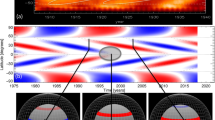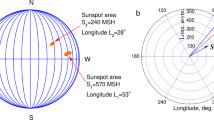Abstract
The spatiotemporal organization of sunspots in the form of activity impulses (according to Gnevyshev’s terminology) is considered as a source of poleward magnetic surges of new polarity. Polar fields in the northern and southern hemispheres have been reconstructed from 1875 to 2012. An increase in the tilt angle of magnetic bipoles with latitude is a crucial parameter in the proposed model to reverse the polar field on the Sun. The role of the surface meridional flow forming magnetic surges of new and old polarities is discussed. It is shown that the velocity and the latitudinal profile of the flow influence the modeled polar field.
Similar content being viewed by others
References
Baumann, I., Schmitt, D., Schussler, M., and Solanki, S.K., Evolution of the large-scale magnetic field on the solar surface: A parameter study, Astron. Astrophys., 2004, vol. 426, pp. 1075–1091.
Charbonneau, P., Dynamo models of the solar cycle, Living Rev. Solar Phys., 2010, vol. 7, no. 3, p. 91.
DeVore, C.R. and Sheeley, N., Jr., Simulations of the Sun’s polar magnetic fields during sunspot cycle 21, Solar Phys., 1987, vol. 108, pp. 47–59.
Dikpati, M., Gilman, P.A., and Ulrich, R.K., Physical origin of differences among various measures of solar meridional circulation, Astrophys. J., 2010, vol. 722, pp. 774–778.
Hale, G.E., Ellerman, F., Nicholson, S.B., and Joy, A.H., The magnetic polarity of sun-spots, Astrophys. J., 1919, vol. 49, pp. 153–178.
Hathaway, D.H., The solar cycle, Living Rev. Solar Phys., 2010, vol. 7, no. 1, p. 65.
Hathaway, D.H. and Rightmire, L., Variations in the axisymmetric transport of magnetic elements on the Sun: 1996–2010, Astrophys. J., 2011, vol. 729, no. 2, p. 80. doi10.1088/0004-637X/729/2/80
Hoeksema, J.T., The large-scale structure of the heliospheric current sheet during the ULYSSES epoch, Space Sci. Rev., 1995, vol. 72, no. 1–2, pp. 137–148.
Jiang, J., Cameron, R.H., Schmitt, D., and Schüssler, M., Can surface flux transport account for the weak polar field in cycle 23? Space Sci. Rev., 2011, p. 136. doi10.1007/s11214-011-9783-y
Leighton, R.B., Transport of magnetic fields on the Sun, Astrophys. J., 1964, vol. 140, pp. 1540–1562.
Mackay, D.H., Magnetic flux transport simulations of solar surface magnetic distributions during a Grand minimum, Solar Phys., 2003, vol. 213, no. 1, pp. 173–193.
Makarov, V.I. and Makarova, V.V., Polar faculae and sunspot cycles, Solar Phys., 1996, vol. 163, no. 2, pp. 267–289.
Nandy, D., Muñoz-Jaramillo, A., and Martens, P.C.H., The unusual minimum of sunspot cycle 23 caused by meridional plasma flow variations, Nature, 2011, vol. 471, no. 7336, pp. 80–82.
Schrijver, C.J. and Liu, Y., The global solar magnetic field through a full sunspot cycle: Observations and model results, Solar Phys., 2008, vol. 252, no. 1, pp. 19–31.
Schrijver, C.J. and Title, A.M., On the formation of polar spots in sun-like stars, Astrophys. J., 2001, vol. 551, no. 2, pp. 1099–1106.
Tang, F., Howard, R., and Adkins, J.M., A statistical study of active regions 1967–1981, Solar Phys., 1984, vol. 91, pp. 75–86.
Van Ballegooijen, A.A., Cartledge, N.P., and Priest, E.R., Magnetic flux transport and the formation of filament channels on the Sun, Astrophys. J., 1998, vol. 501, pp. 866–881.
Wang, Y.-M., Nash, A.G., and Sheeley, N.R., Jr., Evolution of the Sun’s polar fields during sunspot cycle 21 poleward surges and long-term behavior, Astrophys. J., 1989, vol. 347, pp. 529–539.
Wang, Y.-M., Robbrecht, E., and Sheeley, N.R., Jr., On the weakening of the polar magnetic fields during solar cycle 23, Astrophys. J., 2009, vol. 707, no. 2, p. 1372. doi10.1088/0002-637X/707/2/1372
Zolotova, N.V. and Ponyavin, D.I., Nature of the unusually long solar cycles, Proc. Int. Astronomical Union. Symposium, Chouldhary, D.P. and Strassmeier, K.G., Eds., Cambridge, 2011, vol. 273, pp. 169–173.
Zolotova, N.V. and Ponyavin, D.I., Spatial-time clusters of sunspots and solar polar magnetic field reversal, Trudy Vserossiiskoi ezhegodnoi pulkovskoi konferentsii po fizike Solntsa “Solnechnaya i solnechno-zemnaya fizika (Proc. All-Russia Annual Pulkovo Conference on Solar Physics “Solar and Solar-Terrestrial Physics”), 2012a, pp. 47–50.
Zolotova, N.V. and Ponyavin, D.I., Impulse-like behavior of the sunspot activity, Astron. Rep., 2012b, vol. 56, no. 3, pp. 250–255.
Zolotova, N.V. and Ponyavin, D.I., Reconstruction of magnetic field surges to the poles from sunspot impulses, Proc. Int. Astronomical Union. IAU Symposium, Mandrini, C.H. and Webb, D.F., Eds., Cambridge, 2012c, vol. 286, pp. 88–92.
Author information
Authors and Affiliations
Corresponding author
Additional information
The article was translated by the authors.
Rights and permissions
About this article
Cite this article
Zolotova, N.V., Ponyavin, D.I. Spatiotemporal sunspot impulses and reversal of the polar magnetic field on the sun. Geomagn. Aeron. 53, 945–948 (2013). https://doi.org/10.1134/S0016793213080276
Received:
Published:
Issue Date:
DOI: https://doi.org/10.1134/S0016793213080276




